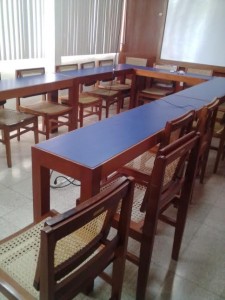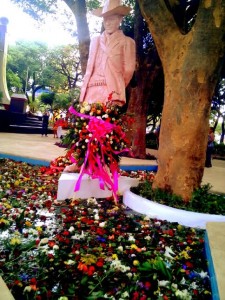After all of the awe-inspiring and exponentially educational involvements I’ve already experienced in my time here in Nicaragua, our first meeting with journalist María López Vigil remains dominant. Maria eloquently outlined the recent history of the Sandinista Revolution that really gave important perspective to my interactions and outlook in this country.
The Samoza family withheld one of the longest dictatorships in American history (remember, we’re still in America down here!) for more than four decades. The Somoza Dynasty came into power in 1937 backed by a strong alliance with the United States. With comprehensive control of the National Guard (created by the US Marines), alternative political affiliations were violently banned, sometimes by torture and mass executions. In the 1960’s, an opposition military movement was building by the name of the Sandinista Liberation Front. General Augusto Sandino, a national hero who fought with an army of working class farmers led against the United States military efforts before his death in 1934. He is used as a symbol for the revolution. In July of 1979, Nicaragua became the first country to defeat placed military by organized guerilla efforts despite lack of equal technology and resources. Unfortunately in the 1980’s, civil war broke out once again by La Contra. After 1979, the National Guard fled to neighboring countries and received underhanded funds from the United States Government. Maria quoted 50,00 were killed, 100,000 were misplaced, and thousands were orphaned by this civil war. In 1990 during multiple party elections, the Sandinista Party surprisingly lost although it afforded Nicaragua so many new opportunities (such as a focus on a health care system and literacy). “The same generation that overthrew a dictatorship with guns overthrew another with votes… There is a strong collective memory and trauma from civil war here; fighting your brothers, sisters, and neighbors,” expressed Ms. López Vigil.
Maria also spoke candidly about the current state of the government by President Daniel Ortega. Nicaragua has moved on to a more neoliberal government where the focus is dominantly focused on the economy rather than the people that make up this beautiful country. There are also strong issues with freedom of the press. The Samoza Family utilized heavy censorship but Maria put it elegantly when describing the Ortega take on information, “They don’t censor, they buy.” The Ortega family has instead bought most of the TV channels, radio stations, and local newspapers. Nicaraguans are also fighting to keep the internet public with great opposition from corporate enterprise that would be directly affected. I asked Maria how people in Nicaragua feel about voting and its effects. Due to election fraud, people are apathetic to voting and therefore don’t bother. “It’s either weapons or votes and votes don’t do anything. Many people in Nicaragua know how to use weapons but that doesn’t get us anywhere. People are afraid war will come back so they are passive.” There is also a huge political struggle against the possible building of a canal via the San Juan River in the south up to Lake Nicaragua, a massive effort that would mark the largest infrastructure in Central America. A Chinese business claims they can complete the canal in just 5 years time and will pay $10 million to the Nica government for 100 years for the business offer. Lake Nicaragua shares the border with Costa Rica and holds the largest biodiversity on this continent. Many international scientists have weighed in on the environmental effects and there have been at least 45 marches and protests in opposition to the building of this canal.
When first setting sights on the Nicaraguan landscape of the city, I was alarmed by the amount of gates, fences, and walls I saw creating so many borders. I didn’t understand the use of armed guards in front of buildings and armed men hanging out of jeeps that I couldn’t differentiate between police and military. Without this background of recent Nicaraguan politics, I wouldn’t have had the proper perspective that is imperative for a non-native and especially one from the United States. Maria López Vigil told my classmates and myself that “with your privilege comes more responsibility.” We aren’t coming into Nicaragua to try to help, we are here to transform the country we come from. In this culture there is a great admiration of blanco skin and hair (expressed not only by the residents but by their lack of people of color in their advertisements), denoting extreme cultural power. This has been a message of many of our acquaintances in our time here, to keep the story of Nicaragua with us and to take it home. Hearing these stories sat very heavy on my heart but again, Maria López Vigil laid it out luminously.
“Optimism is optimism because it is lacking information. Pessimism in your mind, optimism in your heart.”



